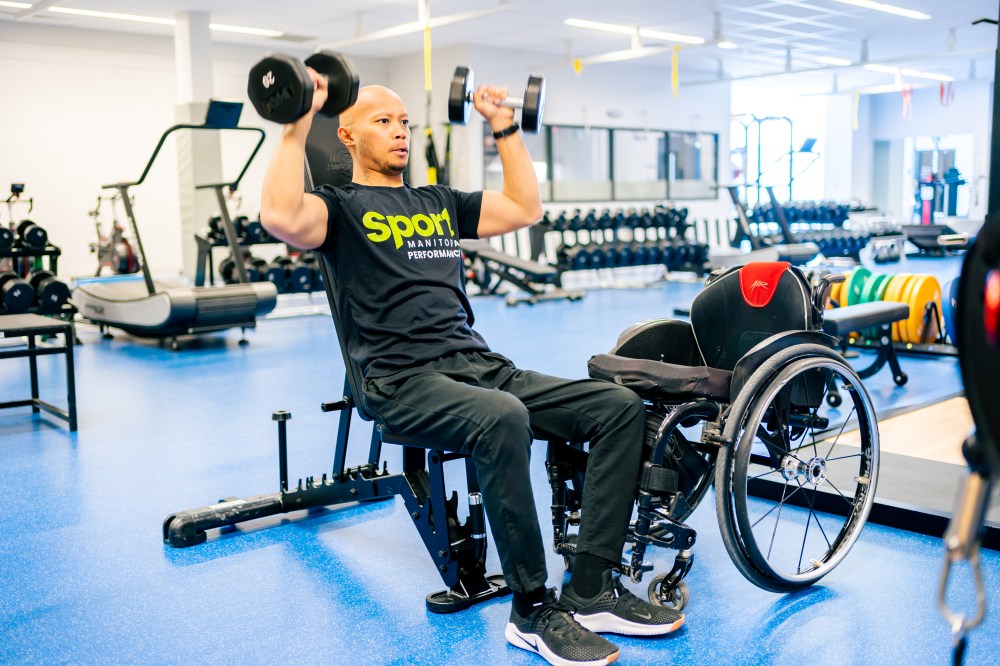Sponsored Content
Creating a Balanced Training Plan for Wheelchair-Based Para Sport Athletes
Advertisement
Read this article for free:
or
Already have an account? Log in here »
To continue reading, please subscribe:
Monthly Digital Subscription
$1 per week for 24 weeks*
- Enjoy unlimited reading on winnipegfreepress.com
- Read the E-Edition, our digital replica newspaper
- Access News Break, our award-winning app
- Play interactive puzzles
*Billed as $4.00 plus GST every four weeks. After 24 weeks, price increases to the regular rate of $19.00 plus GST every four weeks. Offer available to new and qualified returning subscribers only. Cancel any time.
Monthly Digital Subscription
$4.75/week*
- Enjoy unlimited reading on winnipegfreepress.com
- Read the E-Edition, our digital replica newspaper
- Access News Break, our award-winning app
- Play interactive puzzles
*Billed as $19 plus GST every four weeks. Cancel any time.
To continue reading, please subscribe:
Add Free Press access to your Brandon Sun subscription for only an additional
$1 for the first 4 weeks*
*Your next subscription payment will increase by $1.00 and you will be charged $16.99 plus GST for four weeks. After four weeks, your payment will increase to $23.99 plus GST every four weeks.
Read unlimited articles for free today:
or
Already have an account? Log in here »
Hey there, time traveller!
This article was published 23/02/2024 (603 days ago), so information in it may no longer be current.
Wheelchair-based athletes come into the gym to train their grip, upper body, core, and in some cases, parts of their lower body. However, they also use these muscles to compete in their sport and in their day-to-day activities.
The question then becomes, how do we create a training plan that strengthens what muscles the athlete uses without running into burnout or injury? Let’s look at how we can help make this happen.

Plan, Plan, Plan
First things first, you need to get to know your athlete as a human. What is their daily life like in and out of the gym? How many days do they have skill-based training/practices and games for their sport? What are their physical demands needed to complete activities in everyday life (transportation, work/school, personal care, etc.)? Do they plan active and total recovery days? If so, how many? Try your best to plan training and recovery sessions into their schedule at appropriate volumes to avoid burnout.
Try to Balance Movements and Movement Frequency
Does the athlete do a lot of push movements in daily life and in their sport? Try focusing on pull movements in the upper body to prevent injury due to muscle imbalance. A great way to avoid fatigue within a training session is to alternate push and pull movements, followed by a mobility exercise, a power-based exercise, or a core exercise. As always, take an appropriate amount of rest between sets!
Take the Nervous System into Consideration
Some individuals have conditions that affect their nervous system, leading to increased fatigue levels, decreased ability to gain muscle, or challenges when it comes to learning new movements. Allow time for athletes to adjust to new movements, starting with a simplified version if necessary, providing appropriate rest periods, and then layering on increased complexity as the athlete progresses.
Be Creative!
Most of our wheelchair-based athletes can do almost anything an able-bodied athlete can do with some modifications and creativity! This might mean providing a different surface for an athlete to lay on for a bench press, providing straps to secure the athlete to their chair or a bench in certain movements, and by creating an accessible environment.
Quite often, if you talk to the athlete and tell them what you are trying to achieve, they will help you come up with a solution that works for their body. Most athletes are in the gym to be challenged, gain new skills, and improve on current ones – not just to stick with what is comfortable.
Don’t Forget About Mobility
Having proper mobility as an athlete is key to maintaining and improving flexibility, range of motion, and overall muscle function. Performed before and/or after exercise, stretching helps reduce muscle tightness, improve circulation, and prevent injuries.
If you are a Para athlete or individual interested in training, please reach out to us at performance@sportmanitoba.ca or visit sportmanitoba.ca/para-

This article is produced by the Advertising Department of the Winnipeg Free Press, in collaboration with Sport Manitoba

